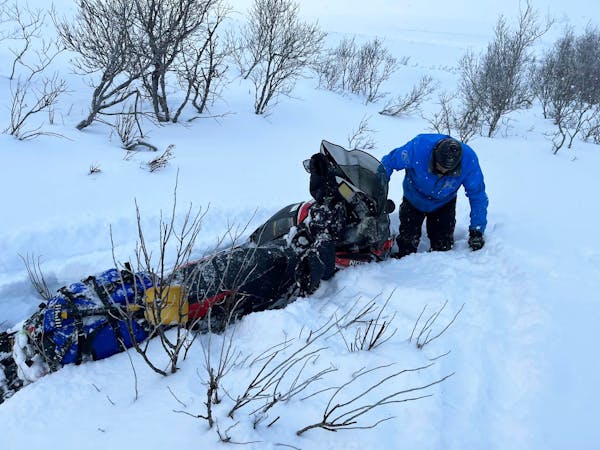Mike Foster and his five older brothers grew up hunting ducks, geese and grouse.
They were good shots and Foster's wingshooting skills served him nicely on his first-ever hunt for wild turkeys.
He drew a turkey tag for the heck of it in the spring of 1979, just one year after Minnesota's inaugural, modern-day turkey season. Curious about the birds but clueless on how to hunt them, Foster got set with his 12 gauge and shouldered it when the birds started to drop from nearby trees, leaving their overnight roosting sites. He fired at one as it flew by.
"I shot him like a big old goose,'' said Foster. "I thought, 'This is really cool.' ''
More than 40 years later, Foster still can't resist the thrill of chasing gobblers in the spring. As approximately 60,000 Minnesotans await the opening of wild turkey season on Wednesday, Foster continues to cheerlead, mentor, and travel long distances for his sport. His most recent seminar, streamed by 300 followers and attended by 50 people at A-1 Archery in Hudson, Wis., was humbly titled, "Turkey Hunting with a Gun or Bow.'' He'll soon be on the road to northeastern Nebraska for his first hunt of 2023.
In a telephone interview this week from his home in Arden Hills, Foster reached into his deep well of experience to offer a range of tips. He's an elite caller, hired nearly two decades ago to the pro staff of Primos Hunting. He started honing his turkey knowledge and skills in the early 1980s on hunting trips to Missouri, where he attended seminars when he wasn't afield.
Back in Minnesota, he joined an early turkey habitat and species seminar hosted by a Department of Natural Resources biologist. After class, he hinted to the instructor that more people would show up if the teachings were more focused on how to bag a bird.
"I still love to turkey hunt,'' said the 79-year-old Foster, long retired from Anchor Paper Co. in St. Paul. "It's fun to be out there."
Foster offers these turkey-hunting tips:
Let the turkey hunt you
Ever wonder why a big tom turkey will approach hen decoys, but stop at a distance out of range? Sometimes that's because the tom expects the hens to approach him. Especially if the hunter is enthusiastically sounding a yelp call, the tom may become suspicious: "If you're so excited, why not come and check me out?''
Consider instead getting rid of the decoys. And be sparing in your use of calls. As the tom hears a yelp, he'll come looking. As he approaches and doesn't see a hen, he might keep searching for her. Why is she being coy? He can sense the exact location of the call and will seek very close if he's curious and not spooked. To further entice the gobbler, keep a small clutch of leaves next to you and scratch it with your hand. If you know how to cluck and purr, now's the time to add those sounds. The tom will read the noises as a hen feeding. "They'll come right to your blind. They keep looking and looking.''
Toys don't make you a good hunter
Two things get turkeys in trouble, Foster said. "Their love life and their routines.'' The best advantage for any turkey hunter is to scout the daily movements of a flock. Especially early in the season before hens begin to nest, flocks move together in patterns. If you know when and where they are accustomed to traveling, set up on their path, preferably at a bend that provides you the best cover. You can be successful with this approach without decoys or a full-fledged blind. The birds will stick to their habit until they know they're being hunted hard.
"If you know where they want to go and what they like to do, that's your best bet,'' he said.
Waiting for the right shot
With a shotgun, you can reach out and kill a bird at 40 or 50 yards. Even without the cover of a ground blind, if you're patient and minimize your use of calls, the turkeys will accommodate that range of distance.
Bow hunters should be more inclined to hunt from a blind because it's tough to draw back without alerting the turkeys. Those archery shots should be made from distances of 10 to 20 yards, with sharp broadheads that can pierce the birds' armor of tight, thick feathers. The vital area is no bigger than a softball, starting near the base of the turkey's neck. But you can also kill or disable a turkey with a clean shot to the back of its neck, along the spine. The trick then is to wait for the bird to raise its head before firing.
Ammunition makers sell special, nontoxic loads designed for turkey hunts. The rounds are expensive, sometimes near $30 a box. They're not entirely necessary but understand that the most avid turkey hunters, those who travel the country in search of different species, depend on them.
Understanding the lonesome tom
Early in the season, turkey hunters should key in on the somewhat predictable movements of big flocks. Big toms are tougher to fool in these times, because they know right where the hens are located. It's important early in the season to rise before dawn and get positioned in the field in darkness. Under normal circumstances, the flock won't descend from roosting spots until there's enough daylight for them to see the ground. Hens are the first to fly.
But the flocks start to break up in mid- to late May, with hens leaving to lay eggs and sit on their nests. Foster said the late season is his favorite time to hunt because big toms are separated from hens, lonely and more vulnerable to being called. In addition, field conditions are drier and warmer and the best action during that part of the season is between 10 a.m. and 2 p.m. "That's when you'll have more luck with the bigger toms and it's in the middle of the day.''

